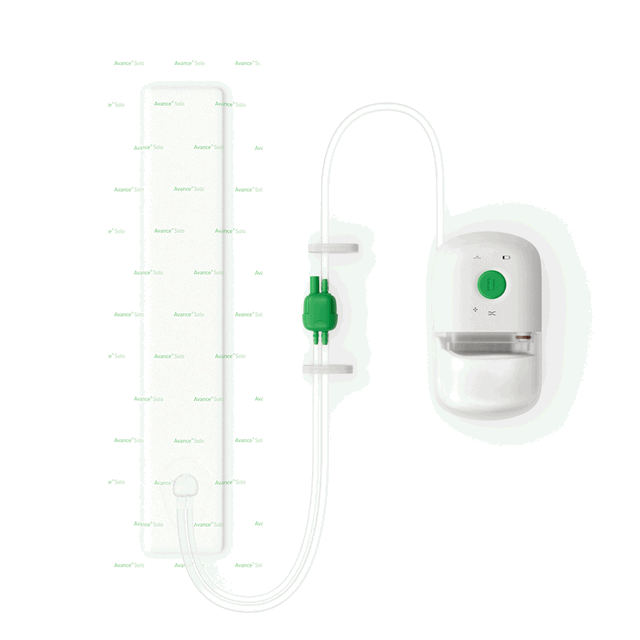Advanced care for high-risk incisions
Incisional NPWT with Avance® Solo
Since its commercial introduction, negative pressure wound therapy (NPWT) has transformed the management of open wounds.1 It has also revolutionised incision care, proving that it offers clinical benefits, from reducing the incidence of surgical site infections,2–7 dehiscence5–7 and oedema1,4 to improving blood flow8,9 and healing.10 The clinically effective range of NPWT lies between –40 and –150 mmHg.11 In a model comparing how well different NPWT systems can reduce peri-wound tension while operating at either –80 or –125 mmHg, –125 mmHg was found to be the most effective.12

Use incisional NPWT after a wide range of surgeries
NPWT can be used in incision care across several surgical specialties, following a variety of surgeries, making it a versatile solution for improving patient outcomes.1,13–21
- Orthopaedics – primary and revision arthroplasties 1
- Cardiothoracic surgery – coronary artery bypass grafts,13 sternotomies14
- Obstetrics and gynaecology – C-sections15
- General and colorectal – Laparotomies,16,17 ventral hernia repairs18
- Vascular surgery – groin incisions19
- Plastic surgery – abdominal wall reconstructions,20 mastectomies21
Consistent incisional NPWT with Avance® Solo
Avance® Solo is our innovative solution for delivering NPWT to closed incisions that are at high risk of surgical site complications and incisions with persistent drainage.22 It’s also indicated in the treatment of open wounds and pressure ulcers.22
Featuring Controlled Fluid Management Technology™, Avance® Solo can effectively manage fluids while delivering a continuous negative pressure of –125 mmHg.22,23–25 Fluid management is shared between the multi-layered dressing and a 50 ml canister.22 The dressing features Safetac® technology, allowing it to gently conform to the skin without sticking to the closed incision.26 This makes removal easy, with minimal pain and trauma to the wound.27–29 Avance® Solo can be used for up to 14 days, promoting undisturbed wound healing.22

Benefits of incisional NPWT with Avance® Solo
- Suitable for high-risk incisions and incisions with persistent drainage
- Features Controlled Fluid Management Technology™
- Fluid management shared between the dressing and a canister
- Delivers a continuous negative pressure of –125 mmHg
- Incorporates Safetac® technology, minimising pain and trauma to the skin and wound during removal
- Can be used for up to 14 days, promoting undisturbed wound healing
Contact sales
If you would like to learn more about Avance Solo, incisional NPWT or how we can help you to optimise incision care in your practice, please use the button below to contact a sales representative.
Contact salesExplore our resources on Avance® Solo and incisional NPWT
-
Avance Solo HCP information
Watch videos to learn how to safely and effectively use the system and deal with errors.
How to use Avance Solo - for healthcare professionals -
Avance Solo patient information
On this page, you’ll find information about how to use and care for your device, as well as instructions on how to respond to different alarms.
How to use Avance Solo - for patients
Build your learning pathway
Covering essential topics for optimal incision care, our Clinical Learning Hub features a growing range of educational materials, from articles and webinars to podcasts and mini-courses.
Start learning today-
- Karlakki S et al. Bone Joint Res. 2013;2:276–84.
- Hyldig N et al. BJS. 2016;103:477–86.
- Rashed A et al. Int Wound J. 2021;18:95–102.
- Ailaney N et al. J Arthroplasty. 2021;36(7):2402–11.
- Pleger SP et al. IntWound J. 2018;15:75–83.
- Wikkeling M et al. J Wound Care. 2021;30(9):705–10.
- Naylor RM et al. World Neurosurg. 2020;137:e257–e262.
- Atkins BZ et al. Int Wound J. 2011;8:56–62.
- Petzina R et al. Eur J Cardiothorac Surg. 2006;30(1):85–9.
- Pachowsky M et al. Int Orthop (SICOT). 2012;36:719–22.
- Birk-Sorenson H et al. J Plast Reconstr Aesthet Surg. 2011;64(Suppl 1):S1–16.
- Henriksson S et al. Poster 69 presented at: American Association of Hip and Knee Surgeons (AAHKS) Annual Meeting; 6–10 November 2024; Dallas, Texas, USA.
- Nherera LM et al. J Cardiothorac Surg. 2018;13(1):103.
- Witt-Majchrzak A et al. Pol Przegl Chir. 2015;86(10):456–65.
- Anderson V et al. Evidence-Based Midwifery. 2014;12:23–8.
- Kuper TM et al. Ann Surg. 2020;271(1):67–74.
- Carter MR et al. Irish Journal of Medical Science. 2016;185:S111.
- Licari L et al. Cureus. 2020;12(5):e8283.
- Svensson-Björk R et al. Br J Surg. 2019;106(4):310–8.
- Condé-Green A et al. Ann Plast Surg. 2013;71(4):394–7.
- Kim DY et al. Plast Reconstr Surg. 2016;138(3):558–66.
- Mölnlycke Health Care AB. Avance Solo NPWT System – Healthcare Professional Instructions for Use. 2020. https://www.molnlycke.co.uk/contentassets/bab0b9b641344d7b9698e313194fcca6/avance-solo-hcp-user-manual.pdf
- Mölnlycke Health Care AB. Data on File (ref. 11).
- Mölnlycke Health Care AB. Data on File (ref. 18).
- Mölnlycke Health Care AB. Data on File (ref. 23).
- White R. Wounds UK. 2005;1(3):104–9.
- Zillmer R et al. J Wound Care. 2006;15(5):187–91.
- Waring M et al. J Wound Care. 2011;20(9):412–22.
- White R. Wounds UK. 2008;4(1).